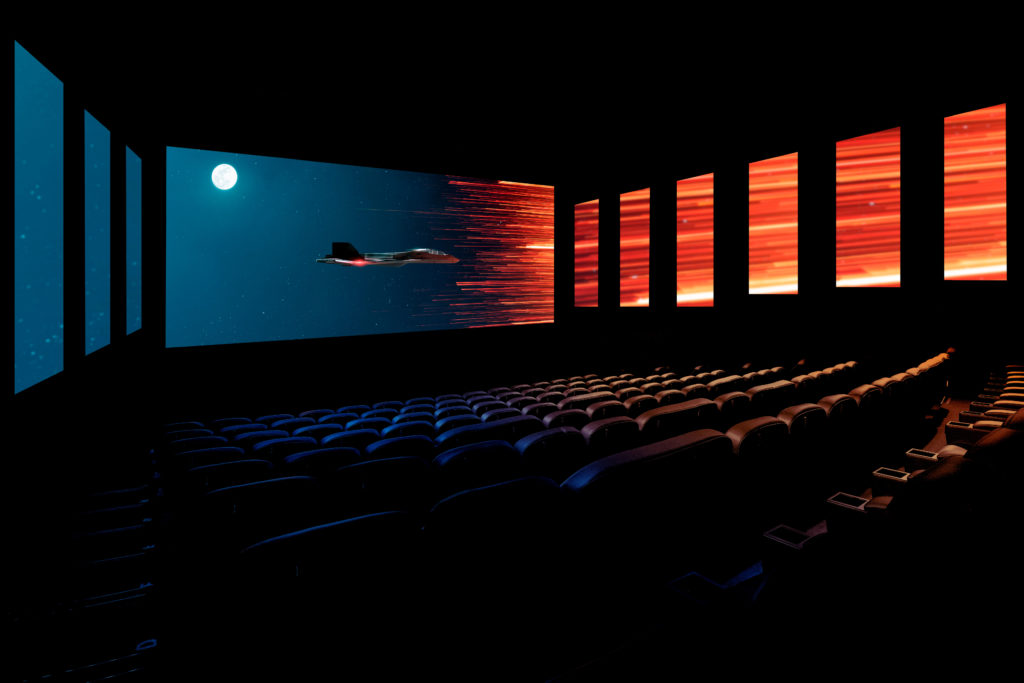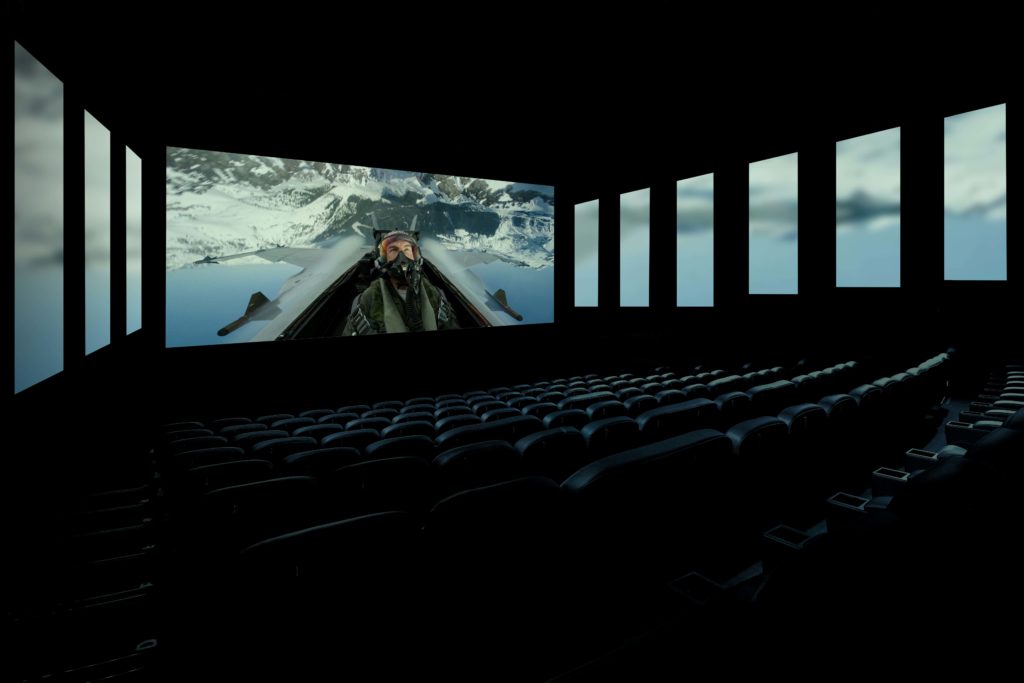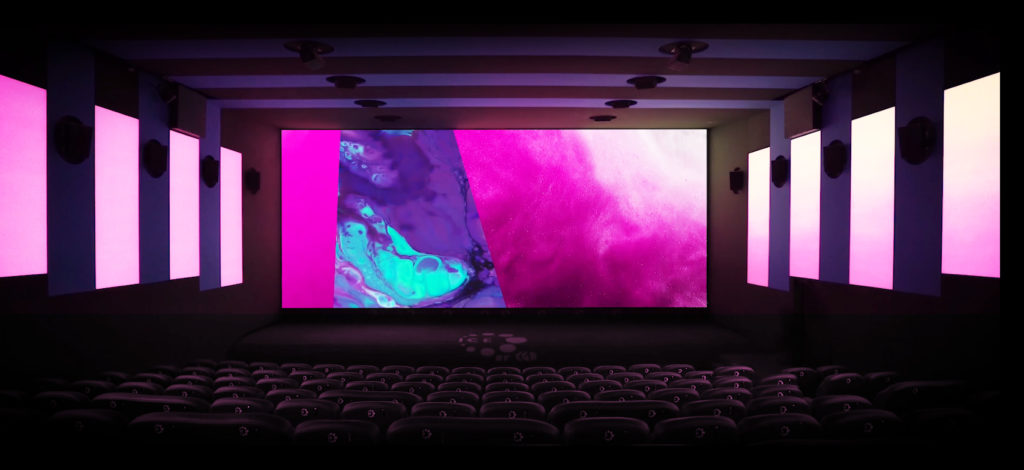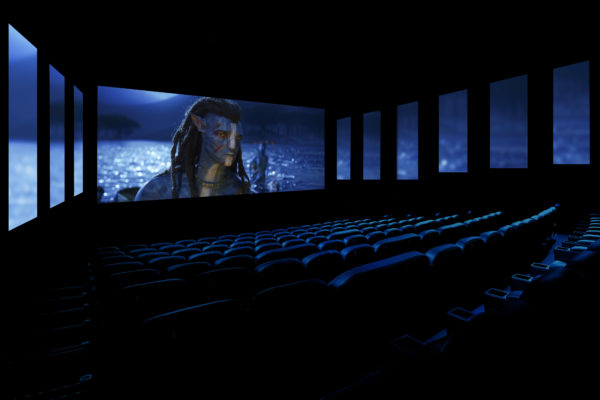Premium large-format (PLF) auditoriums once again emerged as a top choice for global movie audiences in 2022, catapulting titles like Paramount’s Top Gun: Maverick and Universal’s Jurassic World: Dominion to blockbuster levels. In a webinar recorded in early December, weeks ahead of the theatrical release of 20th Century Studios’ Avatar: The Way of Water, Boxoffice LIVE Sessions convened a panel to examine the topic of PLF auditoriums and their growing influence. The panel featured executives from two of the world’s leading cinema chains and was sponsored by ICE Theaters, the panoramic screen format developed by France’s CGR Cinemas. Their conversation was preceded by a presentation by Charlotte Jones, associate director of cinema and movies for data-research firm Omdia, who shared the latest trends and events in the global PLF market. The transcript below includes highlights, edited for length and clarity, of the lively panel discussion that followed.
Panelists
Charlotte Jones, Associate Director, Cinema & Movies, Omdia
Mark Malinowski, V.P. Global Marketing, National Amusements
Guillaume Thomine Desmazures, SVP – Global Sales, ICE Theaters
Clint Wisialowsky, SVP, Business Development & Sales, Marcus Theatres
Listen to Highlights from this conversation of The Boxoffice Podcast

Mark, National Amusements has a presence in the United States, Latin America, and Europe. How have you gone about selling the PLF experience across your markets?
Mark Malinowski: We operate in Brazil, Argentina, and the U.K., and when [Topo Gun: Maverick] opened in all our markets, we promoted it as an experience unlike anything you could see at home. On the PLF side of it, whether that’s Imax or our in-house X Plus auditoriums, we talked up the surround sound, giant screen, laser projection, and comfortable recliners. It worked really well. That film played throughout the month of June and well into the mid-summer in PLF. There were some others that came in to take its place, but Maverick kept coming back and performing on our premium screens. It was our customers’ way of telling us how they wanted to experience this movie.
Clint, what has been your experience with PLF screens at Marcus Theatres, especially during the pandemic recovery?
Clint Wisialowski: I want to build on something Mark just mentioned, about the incredible longevity of Maverick on our premium screens. I hadn’t seen anything like that since the original Avatar. If you go back and look, the first Avatar never made $100 million in a weekend. It had a great opening weekend and just kept performing at the box office, week after week. Maverick did the same. At Marcus, we’ve experienced tremendous success on the PLF side. Even when we’ve had day-and-date releases from studios, the PLF screens are still something that guests seek out. Maverick was one of those movies with sound that shook the seat and visuals that immersed you into the story—you just couldn’t ask for more. We did well on all of the big pictures across our PLF screens. Studios are very competitive to get on those screens, so we end up programming the newest movies—they’re the screens with the highest turnover at any of our locations.
When we talk about an immersive experience, that’s what our colleagues at ICE Theaters—a panoramic screen format—provide at theaters around the world. Guillaume, what were some of the major trends you noticed with your exhibitor partners?
Guillaume Thomine Desmazures: ICE Theaters is part of CGR Cinemas, the second biggest circuit in France. We have 42 ICE Theaters auditoriums across the slightly over 700 screens that are part of our chain, and we’re making 50 to 70 percent of our box office from our PLF auditoriums. We always give our audiences the choice of watching something on a standard or premium screen. While the premium experience is more expensive, the upcharge is not as prohibitive as flying business class versus economy. It’s still something most people can afford, and we’ve realized that most of our patrons choose the premium format because they’re looking for the best experience.
We’ve seen that most exhibitors don’t treat PLF as a one-size-fits-all solution. They diversify to offer different formats across their circuit, sometimes different PLF experiences within the same theater. It can be through a third-party vendor—like ICE Theaters, Dolby Cinema, or Imax—or by taking premium elements and combining them into their own in-house brand, like Regal RPX, Cineplex AVX, or Cinemark XD. Charlotte, as you track the expansion of PLF with your colleagues at Omdia, do you expect this trend of diversification to continue? Or will we begin to see some consolidation in terms of premium brands at the cinema?
Charlotte Jones: Exhibitors are investing across a multiple range of these formats because their audiences are becoming far more discerning. For example, a title may look great on a panoramic screen but not be as well suited to motion seating. Audiences really want to have that choice when they go to the cinema. We have cases where you have some exhibitors with two or three different premium concepts within a particular complex. This is a developing trend, and I believe we will see a lot higher concentration of premium formats in those cinemas where it’s best suited. I don’t think we’ve seen that ceiling yet.
It’s not just the movie that you have to market, you also have to market a higher ticket price. Mark, do you find that to be a challenge as consumer spending has taken a hit around the world?
Mark Malinowski: We believe that if we get our audiences to try our XPlus screens [National Aumusements’ in-house PLF offering], they probably won’t go back. We’ve used loyalty programs in our markets to promote upgrades for those customers who may not have visited our XPlus screens, to encourage them to see their next movie there. We also put a lot of focus on the showmanship side of marketing the premium experience. For example, we have two XPlus screens at our Bluewater location southeast of London. We worked with Disney to create an entire experience around Avatar: The Way of Water, so as you walk into the mall where the theater is located, there are giant projections against the quarry walls promoting the film and our XPlus experience. Stepping inside the theater, we have two giant statues that were commissioned by Disney to celebrate the film. It’s a whole experience before you even get to your seat. We are lucky to have such a great, highly trafficked location in the U.K. to have Disney work so closely with us to co-market our premium experience. You can’t do that for every film, but we were able to spend months planning this campaign with the studio and our mall partner.

Photo Courtesy of ICE Theaters
“The show starts on the sidewalk.” That level of showmanship has always been a staple of this industry. Guillaume, ICE Theaters has exported its concept outside France with different exhibition partners. You’ve recently announced the launch of two new ICE auditoriums in India with PVR, one of the country’s most important chains. What has that experience been like?
Guillaume Thomine Desmazures: You can market the PLF, you can market the movie, and you can market both together. The ICE Theaters concept is easily recognizable for customers: VIP recliner seats, Dolby Atmos sound, laser projection, and peripheral LED panels to create an immersive experience. When it comes to the movie, we are going to cross 30 titles released in the ICE format this year. With PVR, we’ve agreed to add at least 20 Bollywood titles in our format that we can distribute across the region. One of the major challenges we’re seeing with audiences across international markets is finding a way of getting audiences excited to come back to the movies. They spend a lot of their time in front of a small screen, on TikTok, Instagram, and other social media platforms. The theatrical experience isn’t a weekly part of their lives, as it was for me or people of my generation. Many of them aren’t what we would consider frequent moviegoers.
At ICE Theaters, we have created guidelines for every partner we work with to address this challenge through digital marketing. We’ve engaged very powerful influencers in France to promote our experience ahead of Avatar: The Way of Water. For Sonic the Hedgehog 2, for instance, we reached out to local television stations for earned media. That is really, really important, because the more awareness you’re able to create, the more people will come to your theater.
Earned media is so important when we talk about PLF. That’s where you direct moviegoers to your theater instead of any theater. Clint, how has Marcus Theatres been able to make use of that in your local markets?
Clint Wisialowski: Marcus Theatres has been around a long time in the Midwest, and I’ve been given the opportunity to do a number of morning shows, as well as afternoon remotes, on local news channels, promoting upcoming titles, our big theaters, and new food options. Earned media is critical. It’s not an ad, it’s part of your newscast so you’re not going to fast-forward through it—you’re going to be paying attention because it’s part of the news. We’ve done a couple of morning variety shows, and they’ve been very excited about what we give to the audience. It’s an opportunity to brag about your local community, your local theater—and it’s promoting a communal experience that folks can do in their town. We had great traction with stories around Black Panther: Wakanda Forever: hosting school groups at our theaters, musical acts with dancers in our lobbies, and partnering with corporate sponsors and local organizations—these are all things that made the local news. These stories may not always be tied to promoting your PLFs, but we always make it a point to make sure our UltraScreen and SuperScreen auditoriums are featured in the footage. We make sure viewers can see our recliners and the Imax signage in the lobby.

It’s always great to celebrate our success, but it’s also important to note the things that don’t work—especially when you’re talking about a major investment like a PLF auditorium. Guillaume, after having worked within your own circuit in France and with partners around the world, what are some things exhibitors should keep in mind when opening a premium screen?
Guillaume Thomine Desmazures: You need to get the seating right. I insist on it, because you cannot charge 20, 50, or 100 percent above the standard price to a client and give them a standard seat. People have very comfortable sofas at home, flat-screen TVs, and surround sound. You have to deliver the full experience at a PLF auditorium and make sure every part feels like an upgrade. You need to give them a reason to pay the higher ticket price when they come back to your theater. The technology alone won’t do it, you need to get the seating right.
The second piece of advice would be to make sure your staff is trained to welcome guests to your PLF auditorium. Look at the airline industry. When you pay extra for business class, you’re welcomed with a glass of wine. It doesn’t have to be a glass of wine at a cinema, of course, but it’s important to make sure your clients can tell the difference between a standard ticket and a premium auditorium. It’s not enough to just invest in technology and marketing; you need to make sure your staff is aligned with your ambitions for that premium screen.
Mark Malinowski: I think we also need to be clear about the price-value relationship, especially today. What are you offering in your PLF? What is the reason someone would spend a little bit more on this ticket? As soon as you define that, the experience you deliver needs to live up to that standard. We have to deliver on the promise; that’s the key thing. Whether it’s buying a ticket through your website or mobile app, the experience of entering the theater, or then the presentation standards of a premium format once the house lights come down. We have one shot with that customer, especially if it’s their first time at a premium auditorium, to get it right if we want to make sure they come back.
Clint Wisialowski: Our circuit is concentrated across a unique mix of 17 states. We cover the country, but Marcus Theatres was built around the eight contiguous states around Wisconsin. We are very respectful of the dollar for that reason. And Rolando [Rodriguez, former CEO and president of Marcus Theatres], you know, he was very vocal about what we needed to accomplish. And it was attendance; we need people to come to the movies.
A lot of companies have their own brands, but regardless of what we call our in-house PLF auditoriums, we need to make sure that it’s clear to the consumer that they’re receiving a premium experience. People expect more of how they’re being served, how they’re being appreciated if they’re paying a premium. Our job is to make them feel like it was special. The biggest mistake we can make is slapping a PLF moniker and an extra ticket fee on a standard screen. We have a responsibility as an industry to celebrate what we can provide to our guests. That is my word of caution. We all need to maintain our standards—and that applies to all of our screens, not just the premium ones. There is nothing “standard” about a 32-foot screen with great sound, projection, and a recliner. With that in mind, we need to make sure our PLF screens are truly special across the board. We need to make sure that the audience knows what they’re going to get for that extra ticket price.



Share this post